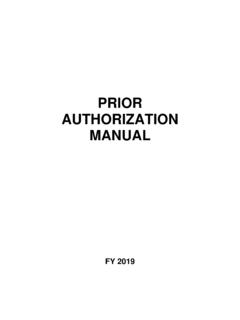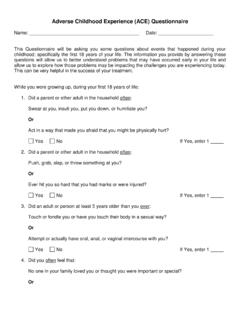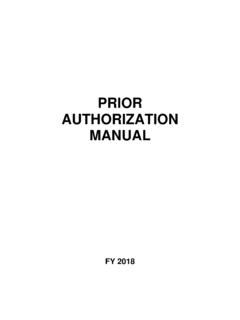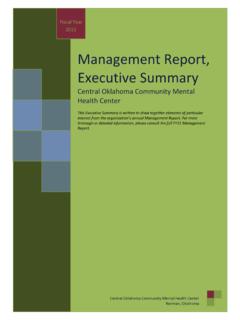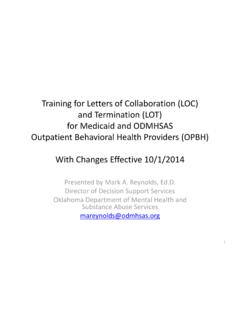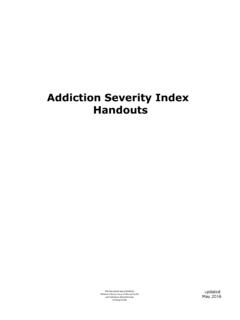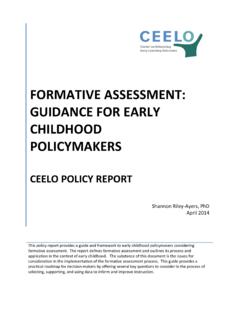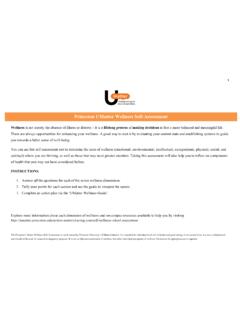Transcription of Client Assessment Record 2010
1 Client Assessment Record (CAR) GENERAL INFORMATION The purpose of the Client Assessment Record (CAR) is to give clinicians a tool to evaluate the functioning level of their customers. The clinician must have knowledge of the customer s behavior and adjustment to his/her community based on the Assessment , and other information. The knowledge must be gained either through direct contact (face-to-face interview) and experience with the customer, or by systematic review of the customer s functioning with individuals who have observed and are acquainted with the customer. The CAR levels of functioning have been structured within a "normal curve" format, ranging from Above Average Functioning (1-10) to Extreme Psychopathology (50).
2 Pathology begins in the 20-29 range. The CAR format provides a broad spectrum of functioning and permits a range within which customers can be described. The clinician s rating in each domain needs to based on Assessment information: 1) the frequency of the behavior (How often does the behavior occur?); 2) the intensity of the behavior (How severe is the behavior?); 3) duration of the behavior (How long does the behavior last?); and 4) the impact the symptoms/behaviors have on daily functioning, to establish the severity of the customer s current condition. Only current information is to be rated, not historical information.
3 CAR DOMAIN DEFINITIONS 1. FEELING/MOOD/AFFECT: Measures the extent to which the person s emotional life is well moderated or out of control. 2. THINKING/MENTAL PROCESS: Measures the extent to which the person is capable of and actually uses clear, well-oriented thought processes. Adequacy of memory and overall intellectual functioning are also to be considered in this scale. 3. SUBSTANCE USE: Measures the extent to which a person s current use of synthetic or natural substances is controlled and adaptive for general well-being and functioning. Although alcohol and illegal drugs are obvious substances of concern, any substance can be subjected to maladaptive use or abuse, especially if compounded by special medical or social situations.
4 4. MEDICAL/PHYSICAL: Measures the extent to which a person is subject to illness, injury and/or disabling physical conditions, regardless of causation. Demonstrable physical effects of psychological processes are included, but not the effects of prescribed psychotropic medications. Physical problems resulting from assault, rape, or abuse are included. 5. FAMILY: Measures the adequacy with which the customer functions within his/her family and current living situation. Relationship issues with family members are included as well as the adequacy of the family constellation to function as a unit. 6. INTERPERSONAL: Measures the adequacy with which the person is able to establish and maintain interpersonal relationships.
5 Relationships involving persons other than family members should be compared to similar relationships by others of the same age, gender, culture, and life circumstances. 7. ROLE PERFORMANCE: Measures the effectiveness with which the person manages the role most relevant to his or her contribution to society. The choice of whether job, school, or home management (or some combination) is most relevant for the person being rated depends on that person s age, gender, culture and life circumstances. If disabled, intellectually, mentally or physically, the Client would be scored relative to others with the same disability and in the same situation.
6 Whichever role is chosen as most relevant, the scale is used to indicate the effectiveness of functioning within the role at the present time. 8. SOCIO-LEGAL: Measures the extent and ease with which the person is able to maintain conduct within the limits prescribed by societal rules and social mores. It may be helpful to consider this scale as a continuum extending from pro-social to anti-social functioning. **Other Behavioral Non-Chemical Addictions would be rated here: gambling, internet, pornography, sexual, etc. 9. SELF CARE/BASIC NEEDS: Measures the adequacy with which the person is able to care for him/herself and provide his/her own needs such as food, clothing, shelter and transportation.
7 If the customer lives in a supportive or dependent situation for reasons other than lack of ability ( confined on criminal sentence), estimate the ability to make arrangements independently and freely. Children, the disabled and elderly persons who are cared for by others should also be rated on their own ability to make arrangements compared to others their age. LEVEL OF FUNCTIONING RATING SCALE 1 - 9 (Above Average): Functioning in the particular domain is consistently better than that which is typical for age, gender, and subculture, or consistently average with occasional prominent episodes of superior, excellent functioning.
8 Functioning is never below typical expectations for the average person. 10 - 19 (Average): Functioning in the particular domain as well as most people of same age, gender, and subculture. Given the same environmental forces is able to meet usual expectations consistently. Has the ability to manage life circumstances. 20 - 29 (Mild to Moderate): Functioning in the particular domain falls short of average expectation most of the time, but is not usually seen as seriously disrupted. Dysfunction may not be evident in brief or casual observation and usually does not clearly influence other areas of functioning. Problems require assistance and/or interfere with normal functioning.
9 30 - 39 (Moderate to Severe): Functioning in the particular domain is clearly marginal or inadequate, not meeting the usual expectations of current life circumstances. The dysfunction is often disruptive and self-defeating with respect to other areas of functioning. Moderate dysfunction may be apparent in brief or casual interview or observation. Serious dysfunction is evident. 40 - 49 (Incapacitating): Any attempts to function in the particular domain are marked by obvious failures, usually disrupting the efforts of others or of the social context. Severe dysfunction in any area usually involves some impairment in other areas.
10 Hospitalization or other external control may be required to avoid life-threatening consequences of the dysfunction. Out of control all or most of the time. 50 (EXTREME): The extreme rating for each scale, suggests behavior or situations totally out of control, unacceptable, and potentially life threatening. This score indicates issues that are so severe it would not be generally used with someone seeking outpatient care. CAR DOMAIN SCORING EXAMPLES FEELING / MOOD AFFECT 1 9 (ABOVE AVERAGE): Anxiety, depression, or disturbance of mood is absent or rare. The person s emotional life is characterized by appropriate cheer and optimism given a realistic Assessment of his/her situation.
